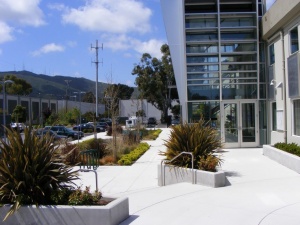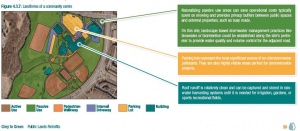LID opportunities at municipal facilities
Each distinct area of your site can be a source for runoff (referred to as a ‘source area’). Target these areas when introducing LID in your municipal facility.
Targeting hard surfaces[edit]
Municipal facilities have large parking lots to accommodate public demand. Parking areas represent the most significant source of pollutant loading from these sites and contribute significantly to increased runoff rates in comparison to natural conditions. Parking lots include areas for parking, areas for driving, and islands or landscape planters used for calming traffic, directing vehicles and improving pedestrian safety.
LID practices can be incorporated into all areas of a parking lot. You can use bioretention in parking lot islands and along the lot perimeter. Standard curbs with small cut-outs (called ‘curb cuts’) can allow water to easily enter biorentention practices while also preventing damage from cars.
Bioswales are excellent options in parking lot islands or along lot perimeters. Parking lots with existing perimeter ditching are ideal for bioswale integration due to their extended continuous flow path.
Prefabricated modular infiltration chambers are gaining acceptance for their easy integration with parking lot functions. These subsurface systems are typically installed over a coarse granular reservoir to provide storage and allow infiltration into native soils. Infiltration chambers under conventional asphalt system work well on sites where parking demand and other site uses do not allow space for a stormwater feature.

Permeable paving is also an option in large municipal parking lots. Pervious concrete, permeable interlocking concrete pavers, and porous asphalt can detain stormwater and increase infiltration.
Municipal facilities provide excellent opportunities for integrating rainwater harvesting systems. Rainwater harvesting systems have two requirements: an area for catchment of relatively clean runoff and a nearby demand for water usage. Municipal facilities often have large rooftop areas producing relatively clean runoff. Installing a cistern internal to the building or buried adjacent to the building can provide a sustainable source of water for site irrigation needs for landscaped areas, recreational fields and indoor use (e.g. flushing toilets and urinals).
Targeting highly visible areas[edit]
If your LID integration strategy involves highly visible LID practices, consider targeting areas with high-volume pedestrian traffic. This can help promote LID's visibility among the public and increase support for future LID projects.
Targeting pollution prevention opportunities[edit]
On some municipal sites, pollution prevention techniques and strategies outlined in Chapter 2 are the best approaches to mitigating the environmental impact of your site. Retrofits of municipal works yards require a different approach than other land uses discussed in this guide. Works yards do not offer substantial opportunities for public interaction. LID retrofits should focus primarily on reducing pollution generated on-site. Fuelling stations, waste storage areas, truck washing stations, sand and salt storage, staging areas and water conveyance features are ideal for pollution prevention.
Source areas[edit]
The best LID option for your site will depend what source areas are present. Types of source areas include:
- Active use areas
- Passive use areas
- Pedestrian walkways
- Internal driveways
- Parking lots
On municipal sites, pollution prevention is often associated with changes to operations and maintenance practices and has not been included in the table below.
| Source area | Permeable pavement | Bioretention | Enhanced grass swales / bioswales | Green roofs | Soakaways and infiltration trenches | Perforated pipe systems | Rainwater harvesting | Landscape alternatives | Prefabricated modules | Pollution prevention |
|---|---|---|---|---|---|---|---|---|---|---|
| Active use area | ** | ** | ** | o | ** | * | o | * | o | ** |
| Passive use area | o | ** | * | o | ** | ** | o | ** | ** | ** |
| Pedestrian walkway | ** | ** | ** | o | ** | * | o | * | * | ** |
| Internal driveway | ** | ** | ** | o | ** | ** | o | o | ** | ** |
| Parking lot | ** | ** | ** | o | ** | ** | o | o | ** | ** |
| Building | * | * | * | ** | ** | * | ** | o | o | ** |
Large-scale projects require significantly more effort, budget, and staff than small-scale projects. Large-scale LID retrofits include:
- Bioretention
- Enhanced grass swales
- Bioswales
- Perforated pipe systems
- Permeable pavement
- Soakaways
- Infiltration chambers
- Rainwater harvesting (excluding rain barrels)
- Prefabricated modules
- Green roofs
Consider a large-scale project if your municipality or department would like to be a leader in sustainability. Large-scale projects are often highly visible and attract more public attention. Large-scale projects may also be the only solution to site-specific challenges. For example, if site infrastructure is at risk as a result of urban flooding, LID practices that detain large volumes of runoff and encourage infiltration are the most viable LID options. Before starting a large-scale retrofit project, consider the following distinctions that set these retrofits apart from small-scale projects.
Integration with capital works programs[edit]
Most large-scale LID retrofits must function with existing site infrastructure, such as storm sewers, catch basins, and pavement systems. The construction of large-scale LID practices often requires these systems to be removed, exposed, or replaced. The best time for this type of project to occur is when an infrastructure replacement or rehabilitation project is already planned.
When LID retrofits are worked into other construction projects, such as parking lot repaving, or grading or drainage improvements, there can be substantial cost savings. Whether big or small, every municipality spends relatively large sums of money and substantial time planning for major capital projects. This includes redevelopment of public building and spaces. Many communities who have undertaken retrofits recognize that even if a relatively small portion of the project funds goes towards LID retrofits, they can retrofit large impervious surfaces and avoid new stormwater management infrastructure projects17.
Municipal facility rehabilitation is typically forecast well in advance of the project. Parking lot paving is typically worked into municipal budgets based on expected life cycle and observed wear. As such, funds may be set aside prior to the project planning phases. Long-term forecast budgets may also be available for site revitalizations or expansions. These budget forecasts provide opportunities to compare the capital and life-cycle costs and benefits of the conventional construction project and LID retrofit.
